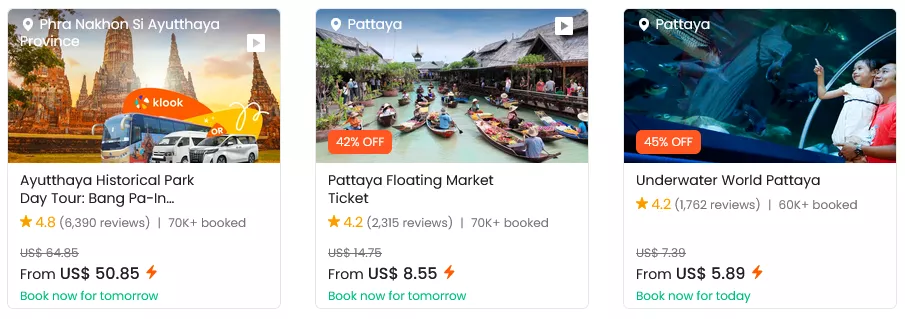
Quick answer: Thailand is a country full of surprises — ancient traditions, joyful festivals, powerful spirituality, and unexpected quirks all mix together. Whether it’s water fights at New Year, masked ghost festivals, or iconic temples, there’s always something fascinating to discover.
At a glance:
- 🎉 Songkran: Thai New Year is famous for huge water fights.
- 👻 Phi Ta Khon: Ghost festival with colourful masks and bamboo steamers.
- 🌿 Nature: Over 150 national parks with rare wildlife and jungle.
- 🕌 Temples: More than 40,000 Buddhist temples across Thailand.
- 🇸🇴 Never Colonised: Thailand kept its unique culture intact.
- 🥊 Muay Thai: National sport blending martial arts and ritual.
- 🏙️ City of Angels: Bangkok’s full name is very long and unique.
- 🛕 Giant Swing: Religious structure in old Bangkok for ceremonies.
Last updated in November 2025.
Discovering the Charm of Thailand: 15 Interesting Things.
-
- As we traverse the intricate mosaic of Thailand’s unique and fascinating aspects, it becomes evident that this Southeast Asian gem is much more than a tropical paradise. It is one of the most popular tourist country in Asia. From the warm smiles that greet you to the ancient traditions that weave through its cultural fabric, Thailand unfolds as a captivating destination that transcends the ordinary.
- The essence of Thailand lies not just in its picturesque landscapes or bustling markets but in the harmonious convergence of tradition and modernity. The Land of Smiles is a testament to the resilience of its cultural heritage, evident in the vibrant festivals that light up the night skies and the centuries-old traditions that continue to shape daily life.
- The floating lanterns of the Yi Peng Festival, dancing gracefully in the night, embody the spirit of letting go and embracing new beginnings. This symbolism echoes through the broader Thai ethos, where resilience and optimism prevail in the face of challenges.
- The Sanctuary of Truth in Pattaya, an architectural marvel crafted entirely from wood, is a testament to Thailand’s commitment to preserving its cultural legacy. It stands tall as a metaphorical bridge connecting the past and the present, inviting visitors to delve into the depths of Thai philosophy and spirituality.
Exploring the Land of Smiles Through Captivating Wonders.
-
- As we explore Thailand’s unique offerings, we encounter the thrill of a water fight during the Songkran Festival, where strangers become friends amid laughter and playful splashes. It’s a reflection of the Thai spirit — vibrant, celebratory, and inclusive.
- The Elephant Sanctuaries, where ethical encounters with gentle giants take precedence, highlight the nation’s dedication to wildlife conservation and responsible tourism. These sanctuaries serve as a reminder of the delicate balance between human enjoyment and nature’s well-being.
- In the world of Thai cuisine, the symphony of flavors creates a sensory experience that goes beyond the palate. It reflects the diversity of the country itself, where each dish tells a story of cultural influences and regional nuances.
- Thailand’s classical masked dance drama, Khon, is a living art form that transports audiences to a realm where myth and reality converge. The intricate movements and vibrant costumes encapsulate the essence of a culture deeply rooted in storytelling and artistic expression.
BOOK a TOUR / ACTIVITY in Thailand ➜
15 Interesting Things and Facts of Thailand:
1. Land of Smiles: Thai Hospitality
In the global tapestry of cultures, Thailand stands out as the „Land of Smiles,“ a title not merely bestowed but earned through a genuine warmth and hospitality that defines the essence of the Thai people. Beyond the stunning landscapes and vibrant cities, it is the gracious smiles and welcoming gestures that leave an indelible mark on every visitor fortunate enough to experience the unique charm of Thai hospitality.
Cultural Roots of Thai Hospitality
-
- At the core of Thai hospitality lies a deep-rooted cultural ethos that places immense value on human connection and harmony. The Thai people take pride in the traditional greeting known as the „wai,“ where palms are pressed together in a prayer-like gesture accompanied by a slight bow. This gesture transcends mere politeness; it symbolizes respect, humility, and an acknowledgment of the shared humanity that binds individuals together.
The Warmth of a Thai Smile
-
- The Thai smile is not just a facial expression; it’s a universal language that communicates a plethora of emotions. It signifies joy, friendliness, and a genuine desire to make others feel at home. Whether you’re navigating the bustling streets of Bangkok or exploring the tranquil villages in the north, the Thai smile is a constant companion, creating an atmosphere of openness and approachability.
The Spirit of Generosity
-
- Thai hospitality extends beyond pleasantries; it encompasses a spirit of generosity deeply ingrained in the culture. Visitors are often treated as honored guests, and the act of sharing is considered a source of joy. From street vendors offering a taste of local delicacies to the warm invitations extended by locals to join in festivals and ceremonies, the generosity of the Thai people leaves an enduring impression.
Hospitality in Thai Homes
-
- One of the most intimate experiences of Thai hospitality is a visit to a Thai home. Guests are welcomed with open arms, and every effort is made to ensure their comfort. Traditional Thai homes often feature a separate space for guests, highlighting the importance placed on providing a sanctuary for those away from their own homes. The offering of food is a common practice, with hosts taking pride in showcasing the richness of Thai cuisine.
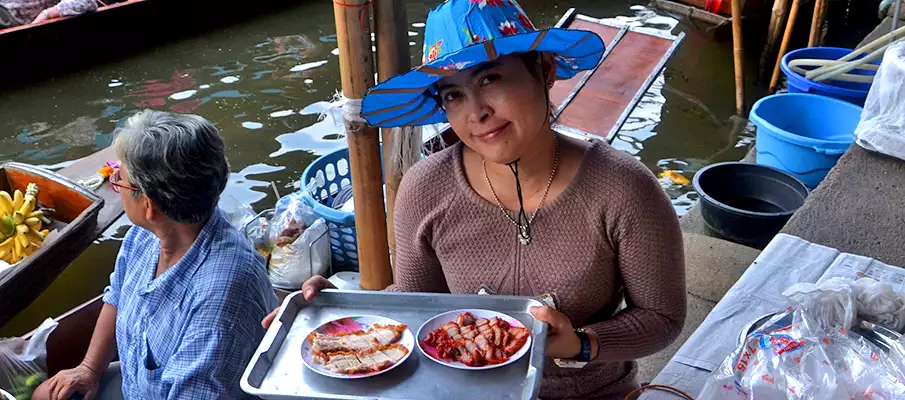
2. Temple Extravaganza: Wat Pho’s Reclining Buddha
Nestled along the banks of the Chao Phraya River in Bangkok, Wat Pho stands as a serene sanctuary, a timeless testament to Thailand’s rich cultural and spiritual heritage. Among the myriad treasures within this sprawling temple complex, none captivates visitors quite like the Reclining Buddha. As you enter the hallowed grounds of Wat Pho, a palpable sense of tranquility envelops you, setting the stage for an encounter with a marvel that transcends both artistry and spirituality.
The Majestic Reclining Buddha: A Symbol of Enlightenment
-
- Stepping into the Viharn Phranorn, visitors are greeted by the awe-inspiring sight of the Reclining Buddha—a colossal masterpiece that stretches an impressive 46 meters in length. Beyond its sheer size, the statue’s significance lies in its representation of the Buddha’s entry into Nirvana. The intricately adorned feet, with mother-of-pearl inlays depicting auspicious symbols, narrate a visual story of the virtues one must cultivate on the path to enlightenment. It’s a sacred embodiment of Thai Buddhism’s core principles, inviting contemplation and reverence.
Narrative Murals: Painting the Story of Buddhism
-
- The journey within Wat Pho is not confined to the colossal statue alone; vibrant murals adorning the temple walls offer a visual narrative of Buddhist cosmology and the life of the Buddha. Each brushstroke seems to breathe life into the tales, creating an immersive experience that complements the spiritual significance of the Reclining Buddha. The marriage of art and spirituality within the temple walls transports visitors into a realm where the past unfolds in a vibrant tapestry of color and meaning.
Beyond Statues: Tranquility and UNESCO Recognition
-
- Wat Pho’s allure extends beyond the Reclining Buddha and the ornate structures. The temple’s courtyards and gardens, meticulously landscaped, offer a serene escape from the urban hustle. Amidst pagodas and sculptures, visitors find solace—a space where the spiritual essence of Wat Pho permeates the soul. Recognizing the temple’s dedication to preserving traditional knowledge, UNESCO has bestowed its recognition, solidifying Wat Pho’s status as not just a national treasure but a global cultural legacy.

3. Floating Markets: Damnoen Saduak’s Aquatic Bazaar
In the meandering canals just outside Bangkok lies the enchanting Damnoen Saduak, a Floating Market that beckons with its unique blend of tradition and commerce. As visitors meander through the labyrinthine waterways, they are greeted by a visual extravaganza—a vibrant display of long-tail boats adorned with a kaleidoscope of fruits, vegetables, and handcrafted wares. The lively banter of vendors and the rhythmic negotiation between buyers create a dynamic tapestry that mirrors the soul of Thailand’s traditional floating markets.
A Visual Symphony on Water
-
- The allure of Damnoen Saduak extends beyond the visual spectacle to a culinary journey. Amid the bustling aquatic atmosphere, the aroma of Thai street food permeates the air. Skilled chefs operate floating kitchens, tantalizing taste buds with Pad Thai, coconut ice cream, and an array of local delicacies. The Floating Market transforms into a gastronomic paradise, inviting visitors to indulge in the diverse flavors that define Thai cuisine.
Culinary Delights Amidst Floating Kitchens
-
- Yet, Damnoen Saduak is more than a marketplace; it’s a haven of craftsmanship and cultural immersion. Among the floating stalls, a treasure trove of artisanal crafts and souvenirs awaits exploration. Handcrafted trinkets, traditional clothing, and intricately designed ornaments showcase the rich artistic heritage of Thailand. Engaging with local vendors becomes a cultural exchange, where each purchase becomes a meaningful connection to the craftsmanship that has flourished here for generations.
Artisanal Treasures on Floating Stalls
-
- The Floating Market isn’t just a tourist attraction; it’s a living testament to the daily lives and traditions of the Thai people. Visitors become integral to the ebb and flow of this dynamic marketplace, forging connections beyond the transactional. Damnoen Saduak’s Aquatic Bazaar encapsulates the spirit of Thailand, where commerce and culture intertwine seamlessly, creating an experience that transcends the boundaries of time and tradition.
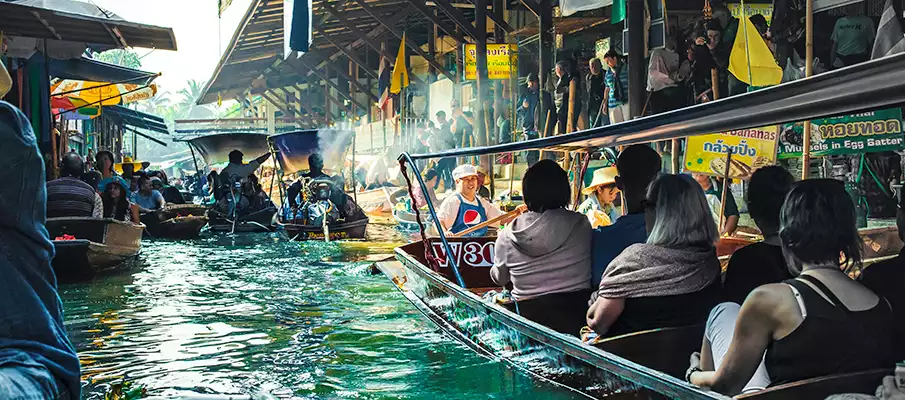
4. Songkran Festival: Thailand’s Water Fight Extravaganza
In the heart of Thailand, amidst the scorching heat of April, the Songkran Festival emerges as a vibrant celebration that transcends traditional boundaries. Renowned as the Thai New Year, Songkran is more than just a change in the calendar; it’s a water-soaked extravaganza that symbolizes purification, renewal, and the sheer joy of communal spirit. Stepping into the midst of Songkran is immersing oneself in a riot of colors, laughter, and the playful symphony of water.
A Splash of Tradition: Origins of Songkran
-
- As the sun graces the skies with its warmth, Songkran kicks off, marking the beginning of the Thai New Year. Rooted in centuries-old traditions, Songkran is a time for Thais to pay homage to their elders, visit temples, and engage in acts of merit. Water, a symbol of cleansing and renewal, takes center stage, transforming the festival into a nationwide water fight that unites locals and visitors alike.
Water Wars: The Heart of Songkran Revelry
-
- The heart of Songkran lies in the water fights that break out in every corner of the country. From bustling city streets to quaint villages, the air is filled with the sound of laughter and the exhilarating splashes of water. Buckets, water guns, and even elephants become vessels for joyous water battles. Strangers become friends as the boundaries of formality dissolve in the refreshing deluge, creating an atmosphere of pure, unbridled celebration.
Symbolic Splashes: Purification and Blessings
-
- The water fights of Songkran are not merely about merriment; they carry profound symbolism. The splashes of water are believed to cleanse not just the body but also the spirit, washing away the sins and misfortunes of the past year. It’s a collective purification that brings forth a sense of renewal and optimism as Thailand embraces the approaching year with a clean slate.
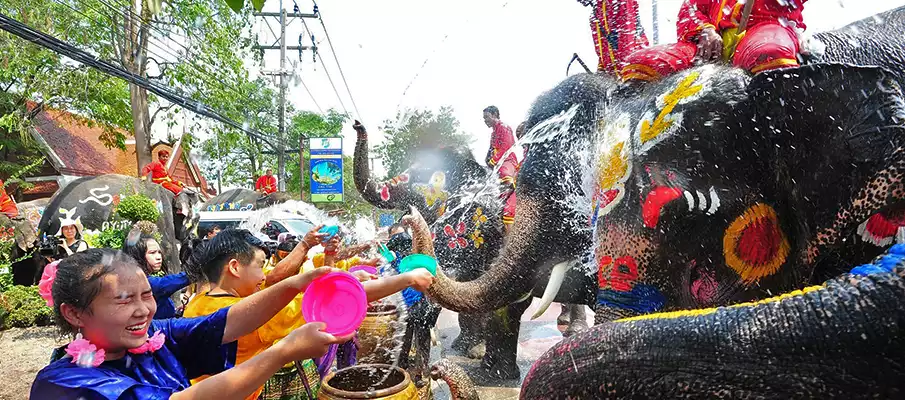
5. Phi Phi Islands: Tropical Paradise Unleashed
Nestled in the Andaman Sea like jewels waiting to be discovered, the Phi Phi Islands stand as a tropical paradise that captivates the hearts of all who set foot on their powdery shores. Comprising six islands, with Phi Phi Don and Phi Phi Leh being the most famous, this archipelago beckons travelers with its crystalline waters, limestone cliffs, and vibrant marine life. Unveiling the Phi Phi Islands is not just a journey; it’s an immersion into the splendor of nature’s artistry and the allure of a pristine tropical escape.
A Symphony of Blue: Crystal Clear Waters
-
- The allure of the Phi Phi Islands begins with the mesmerizing shades of blue that surround them. The crystal-clear waters reveal a world of underwater wonders, making snorkeling and diving experiences nothing short of magical. Vibrant coral reefs teem with life, and schools of tropical fish glide gracefully through the underwater gardens, creating a symphony of colors beneath the surface.
Phi Phi Leh: The Cinematic Wonder
-
- Phi Phi Leh, the smaller but equally enchanting sister island, gained international fame as the backdrop for the movie „The Beach.“ Its secluded coves, hidden lagoons, and towering cliffs create a cinematic canvas that leaves visitors in awe. The Maya Bay, with its powdery white sand and emerald waters, stands as a testament to the untouched beauty that defines the Phi Phi Islands.
Beach Bliss on Phi Phi Don: A Tropical Haven
-
- Phi Phi Don, the largest and only inhabited island in the archipelago, is a haven for beach lovers. Long Beach and Loh Dalum Bay boast stretches of soft sand fringed by swaying palm trees, inviting visitors to indulge in the blissful simplicity of sun-soaked afternoons and sunset strolls. The relaxed atmosphere and warm hospitality on Phi Phi Don create an idyllic backdrop for an unforgettable tropical retreat.
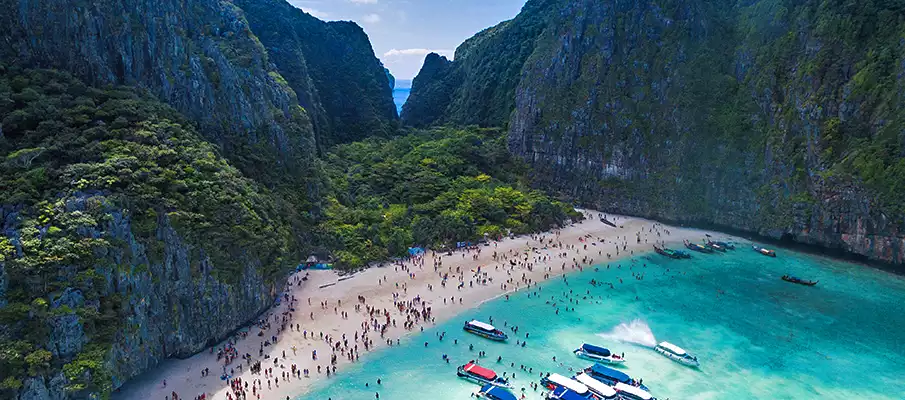
6. Thai Cuisine + Food: A Symphony of Flavors
In the realm of culinary delights, Thai cuisine emerges as a vibrant symphony that tantalizes the taste buds and transcends the ordinary. Renowned globally for its harmonious blend of sweet, savory, spicy, and sour, Thai dishes are a celebration of flavors that reflect the nation’s rich cultural tapestry. Embarking on a culinary journey through Thailand is not just a meal; it’s an exploration of a symphony that dances across the palate with each mouthwatering bite.
The Essence of Thai Flavors: Sweet, Spicy, Sour, and Salty
-
- At the core of Thai cuisine lies a profound understanding of the balance between flavors. Sweetness from palm sugar, spiciness from chilies, sourness from lime, and saltiness from fish sauce come together in perfect harmony. Whether savoring the succulent notes of Pad Thai or diving into the fiery embrace of Tom Yum soup, each dish showcases the artistry of Thai chefs in crafting a symphony of tastes that leave an indelible mark.
Street Food Extravaganza: Culinary Adventures in Every Bite
-
- Thai street food is a gastronomic adventure that unfolds in every corner. Vibrant markets come alive with the sizzle of woks and the aromatic waft of herbs and spices. From the iconic Som Tum (green papaya salad) to the flavorful skewers of Moo Ping (grilled pork), street vendors beckon with a diverse array of culinary treasures, inviting locals and travelers alike to partake in the sensory feast.
Regional Nuances: Diverse Flavors Across Thailand
-
- The symphony of Thai cuisine is not a monolithic melody but a rich composition with regional variations. From the fiery curries of the south to the aromatic dishes of the north, each region contributes its unique notes to the culinary score. The richness of Massaman curry, the herbal fragrances of Northern Thai larb, and the seafood delights of the coastal areas showcase the diversity that makes Thai cuisine a captivating ensemble.
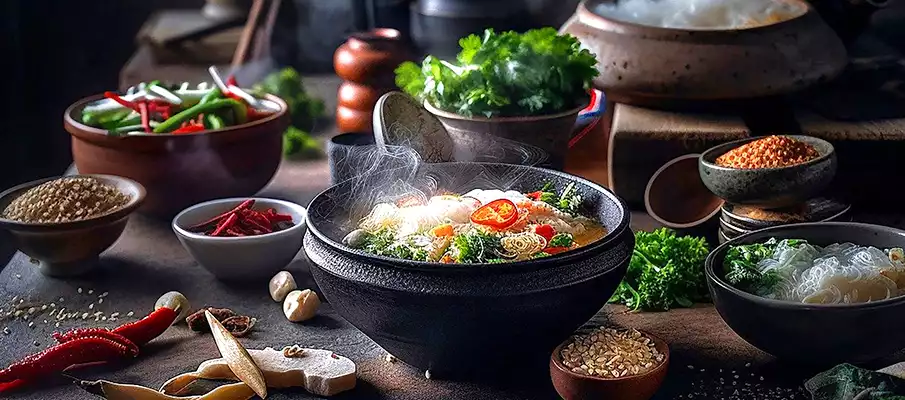
7. Loy Krathong: Lanterns Aglow on Water
Embarking on a cultural journey through Thailand reveals a dazzling spectacle known as Loy Krathong—a festival where lanterns gracefully illuminate the waterways, creating a breathtaking symphony of light and reflection. Beyond a mere celebration, Loy Krathong is a cultural ode to gratitude, renewal, and the serene beauty of Thai traditions. It’s a mesmerizing experience where lanterns aglow on water weave a narrative that transcends time.
Gratitude and Renewal: The Essence of Loy Krathong
-
- Loy Krathong, often called the Festival of Lights, is rooted in expressions of gratitude and a symbolic act of letting go of negativity. As night falls, people gather along rivers, lakes, and canals with krathongs—small, beautifully decorated floating vessels. Each krathong carries a prayer or wish, transforming the water into a serene canvas of flickering lights that mirror the collective hopes and aspirations of those partaking in the festival.
A River of Lanterns: Illuminating the Night
-
- As the krathongs gracefully float downstream, their candles casting a warm glow, the water becomes a river of lanterns. The sight is nothing short of enchanting—the flickering lights create a serene ambiance, and the gentle ripples reflect the tranquility of the moment. It’s a visual symphony that encapsulates the spiritual essence of Loy Krathong.
Traditional Ceremonies: Temples and Cultural Practices
-
- Loy Krathong is not confined to waterways; it extends to temples where traditional ceremonies unfold. At Wat Phan Tao in Chiang Mai, for example, a grand procession and ceremony take place, further enriching the cultural significance of the festival. These ceremonies, often accompanied by traditional music and dance, deepen the connection between participants and the age-old traditions they are celebrating.
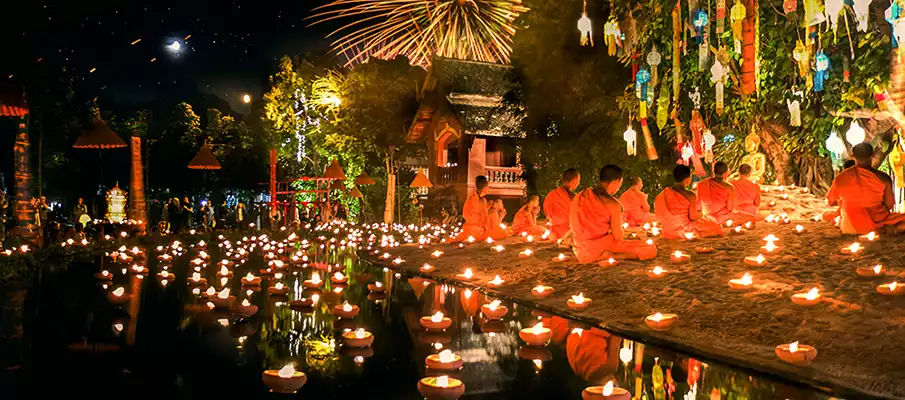
8. Elephant Sanctuaries: A Haven for Gentle Giants
Journeying through Thailand unveils a haven of compassion and care known as Elephant Sanctuaries—an oasis where majestic creatures find solace and visitors engage in ethical and educational interactions. More than a tourist attraction, these sanctuaries embody a commitment to the welfare of Thailand’s elephants, offering a unique blend of education, conservation, and a chance to witness the gentle giants in their natural habitat.
Ethical Interaction: A Paradigm Shift in Elephant Tourism
-
- Elephant Sanctuaries represent a departure from traditional forms of elephant tourism. Here, the emphasis is on ethical interaction—no riding, no performances, just observing and learning about these magnificent creatures. Visitors have the opportunity to feed, bathe, and walk alongside the elephants, fostering a deeper connection and understanding of their natural behaviors.
Educational Initiatives: Advocacy for Elephant Welfare
-
- Beyond providing a sanctuary, these centers serve as educational hubs, advocating for the welfare of elephants in captivity. Visitors gain insights into the complex lives of these gentle giants, learning about the challenges they face and the importance of conservation efforts. The hope is that every visitor becomes an ambassador for elephant welfare, spreading awareness to mitigate the threats these creatures encounter.
Natural Habitats: Creating Spaces for Well-Being
-
- Elephant Sanctuaries prioritize creating natural habitats that mirror the elephants‘ wild environment. Immersed in lush greenery and open spaces, the gentle giants have the freedom to roam, socialize, and express natural behaviors. This shift from confined spaces to expansive sanctuaries contributes significantly to their physical and psychological well-being.
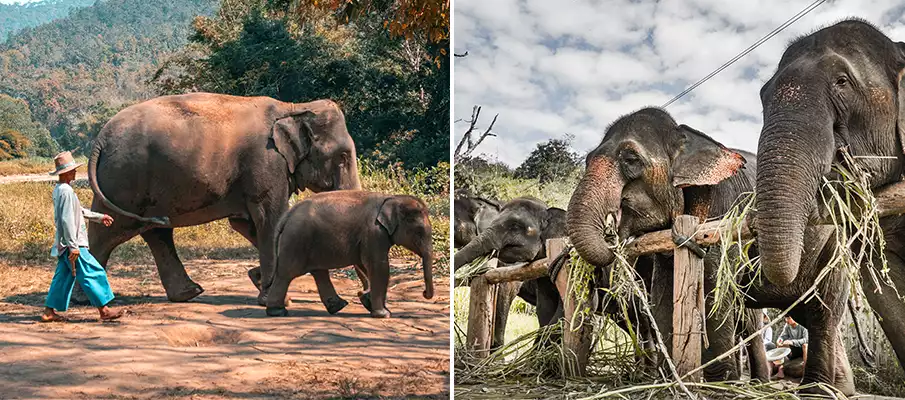
9. Ayutthaya Historical Park: Ancient Glory Restored
Exploring the heart of Thailand unveils a treasure trove of history, where the Ayutthaya Historical Park stands as a testament to the grandeur of a bygone era. This UNESCO World Heritage Site resurrects the ancient glory of the Kingdom of Ayutthaya, offering visitors a captivating journey through time, where remnants of temples, palaces, and statues whisper tales of a once-mighty civilization.
Cultural Time Capsule: Ayutthaya’s Storied Past
-
- Ayutthaya, the second capital of the Siamese Kingdom, flourished for over four centuries, from the 14th to the 18th century. The Historical Park encapsulates the city’s rich history, where towering prangs (reliquary towers), Buddha statues, and the remnants of royal palaces serve as a cultural time capsule. Each stone and brick echoes the stories of a vibrant and prosperous kingdom that thrived along the Chao Phraya River.
Architectural Marvels: Temples and Prangs
-
- Wandering through the park unveils architectural marvels that showcase the ingenuity of Ayutthaya’s builders. Wat Mahathat, with its iconic Buddha head entwined in the roots of a banyan tree, and Wat Chaiwatthanaram, with its imposing prang overlooking the river, stand as poignant reminders of the city’s artistic and religious legacy. The intricate carvings and imposing structures transport visitors to a time when Ayutthaya was a beacon of cultural and economic prowess.
Historical Significance: UNESCO World Heritage Recognition
-
- The historical significance of Ayutthaya transcends its physical structures. Recognized as a UNESCO World Heritage Site, the park stands as a global symbol of cultural heritage preservation. The meticulous restoration efforts undertaken by Thai authorities ensure that future generations can marvel at the splendor of Ayutthaya’s past and appreciate its contributions to the cultural mosaic of Southeast Asia.
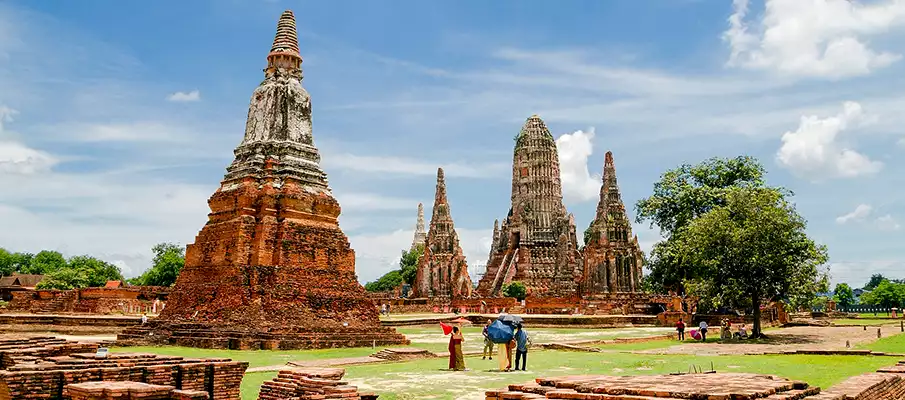
10. Tuk-Tuks: The Iconic Thai Ride
Embarking on a journey through Thailand introduces travelers to a symbol of local charm and a ubiquitous mode of transport—the Tuk-Tuk. These three-wheeled wonders are not merely a means of getting from point A to B; they are an integral part of the Thai experience, embodying the country’s vibrant energy, colorful culture, and the spirit of adventure.
Street Symphony: The Tuk-Tuk’s Roaring Presence
-
- Navigating the bustling streets of Bangkok or the quaint lanes of Chiang Mai, the unmistakable roar of a Tuk-Tuk’s engine becomes a symphony of the urban landscape. With their distinctive design and open-sided structure, Tuk-Tuks embody the spirit of Thai mobility, weaving through traffic with agility and announcing their presence with a characteristic purr.
Iconic Design: Tuk-Tuks as Rolling Canvases
-
- Tuk-Tuks are not just vehicles; they are rolling canvases adorned with a kaleidoscope of colors, patterns, and sometimes humorous slogans. Each Tuk-Tuk is a unique piece of mobile art, reflecting the personality and creativity of its owner. The vibrant exteriors mirror the lively atmosphere of Thai streets, creating a visual spectacle that adds to the overall charm of the urban landscape.
Flexible Routes: A Tailored Tour Experience
-
- What sets Tuk-Tuks apart is their flexibility. Unlike conventional taxis, Tuk-Tuks can navigate through narrow alleys and take unconventional routes, providing passengers with an immersive and personalized tour experience. Whether darting between markets or cruising along the scenic coastline, the Tuk-Tuk transforms a simple journey into a dynamic exploration.

11. Hill Tribes: Cultural Diversity in Northern Thailand
Venturing into the northern landscapes of Thailand unveils a tapestry of cultural richness embodied by the Hill Tribes. Nestled in the lush greenery of the mountainous regions, these communities are not just inhabitants; they are the living storytellers of a diverse cultural heritage that adds layers of depth to Thailand’s social fabric.
Diverse Tapestry: Hill Tribes‘ Cultural Mosaic
-
- The Hill Tribes encompass a variety of ethnic groups, each with its distinct language, customs, and traditional practices. From the Akha and Karen to the Hmong and Lisu, these tribes weave a cultural mosaic that reflects centuries-old traditions, providing a glimpse into the multifaceted identity of Northern Thailand.
Traditional Attire: A Visual Expression of Heritage
-
- One striking aspect of Hill Tribe communities is their traditional attire. Colorful textiles, intricate embroidery, and ornate accessories form garments that are not just clothing but visual expressions of cultural identity. Each tribe’s distinctive attire tells a unique story, serving as a testament to their history, beliefs, and artistic flair.
Sustainable Lifestyles: Living in Harmony with Nature
-
- The Hill Tribes‘ way of life is intimately connected to the natural surroundings of the mountainous terrain. Embracing sustainable practices, these communities cultivate crops, engage in handicrafts, and live in harmony with the land. The traditional agricultural methods and eco-friendly lifestyles of the Hill Tribes exemplify a deep respect for the environment.
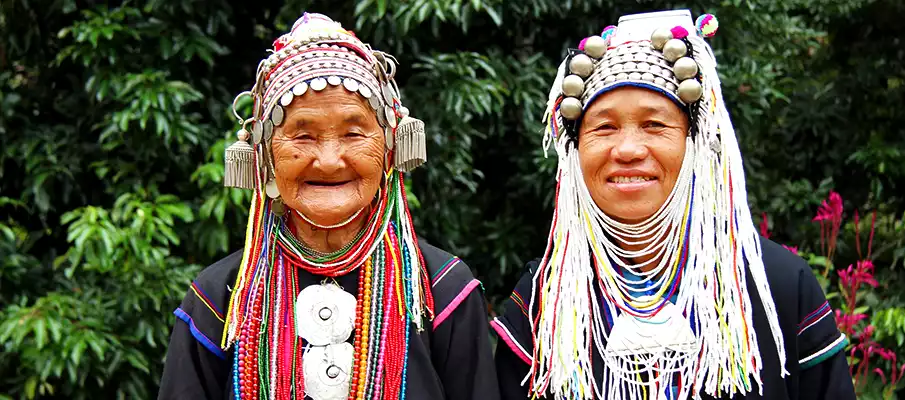
12. Golden Triangle: Confluence of Cultures
Exploring the northernmost reaches of Thailand unfolds the mesmerizing tapestry of the Golden Triangle—a region where the Mekong River meanders, marking the confluence of borders and cultures. Far beyond its geographical significance, the Golden Triangle encapsulates a historical, cultural, and economic crossroads that has shaped the identity of Southeast Asia.
Historical Crossroads: Legacy of Trade and Commerce
-
- The Golden Triangle holds a storied past as an epicenter of trade and commerce. Historically, it was a meeting point for merchants from Thailand, Laos, and Myanmar, exchanging goods and cultural influences along the ancient trade routes. This convergence of civilizations has left an indelible mark on the region, fostering a rich and diverse cultural landscape.
Cultural Fusion: Diverse Ethnolinguistic Groups
-
- The Golden Triangle is home to a myriad of ethnolinguistic groups, including the Akha, Lisu, and Yao, among others. Each group contributes to the region’s cultural kaleidoscope, showcasing distinct traditions, languages, and rituals. Exploring the villages along the Mekong provides a glimpse into the coexistence and interaction of these diverse cultures.
Opium Trade History: Shadows of the Past
-
- The Golden Triangle was historically associated with the opium trade, adding a complex layer to its narrative. While the region has moved away from its opium-producing past, remnants of that era linger. Museums and historical sites delve into this aspect, offering insights into the socio-economic dynamics that once shaped the Golden Triangle.
Mekong River: The Lifeline of the Region
-
- The Mekong River, flowing through the heart of the Golden Triangle, is not merely a waterway but a lifeline that sustains communities along its banks. The river serves as a cultural conduit, connecting people from different nations and facilitating the exchange of traditions, beliefs, and practices.
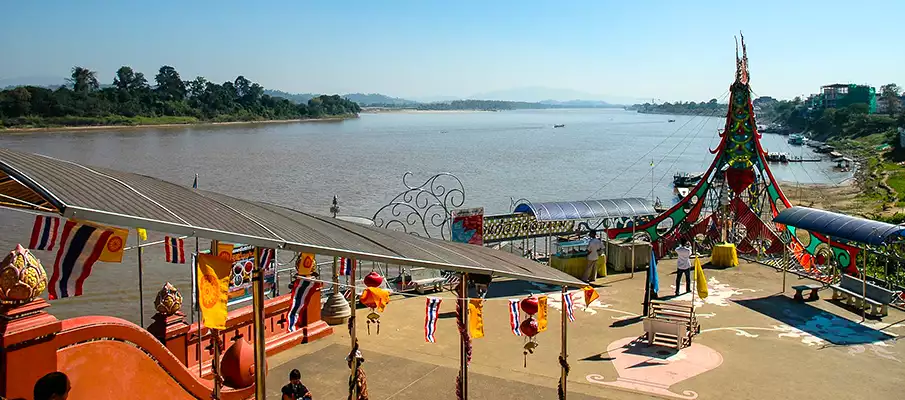
13. Jim Thompson House: Silk and Mystique
Nestled in the heart of bustling Bangkok, the Jim Thompson House emerges as a cultural gem, weaving together the threads of silk and mystique. This iconic residence, once belonging to the enigmatic American businessman Jim Thompson, stands as a testament to his passion for Thai silk and his role in revitalizing the country’s traditional silk industry.
Architectural Elegance: A Harmonious Thai Abode
-
- Jim Thompson’s house is a masterpiece of architectural fusion, seamlessly blending traditional Thai design elements with Western influences. Surrounded by lush gardens and intricately carved teakwood structures, the house exudes an air of serenity—a stark contrast to the urban energy just beyond its walls.
Silk Legacy: Reviving Thai Craftsmanship
-
- Jim Thompson’s imprint on Thailand’s silk industry is profound. Captivated by the beauty of Thai silk during his post-World War II travels, Thompson dedicated himself to revitalizing the traditional craft. His efforts not only brought Thai silk to the international forefront but also contributed to the economic well-being of local weavers and artisans.
Intricate Collections: Treasures from Across Southeast Asia
-
- The interiors of the Jim Thompson House are adorned with a rich array of Southeast Asian art and antiques. From intricate sculptures and rare ceramics to vibrant textiles and tapestries, the collections reflect Thompson’s discerning taste and his commitment to preserving the cultural heritage of the region.
Mysterious Disappearance: A Legacy Shrouded in Intrigue
-
- The mystique surrounding Jim Thompson extends beyond his contributions to the silk industry. His sudden disappearance in the Malaysian Highlands in 1967 remains an unsolved mystery. The enigma of Thompson’s life adds an extra layer of fascination to the house, inviting visitors to contemplate the man behind the silk legacy.
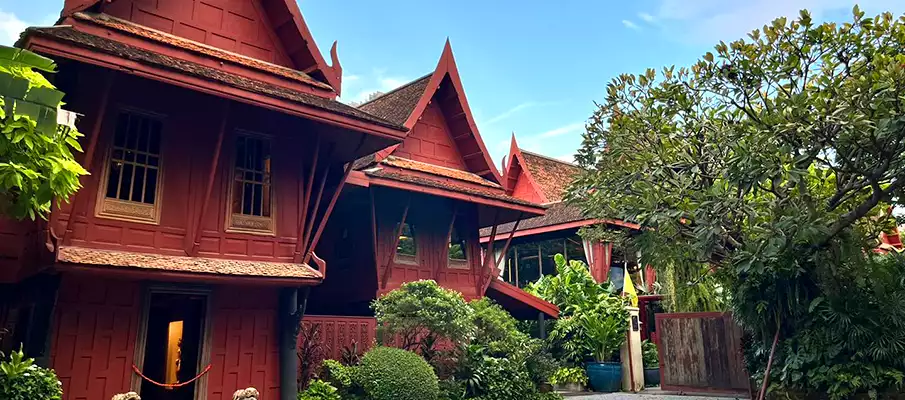
14. Muay Thai: The Art of Eight Limbs
In the realm of combat sports, Muay Thai stands as a formidable and elegant art, earning its moniker as the „Art of Eight Limbs.“ Rooted in ancient tradition and revered for its intensity, Muay Thai is more than a sport; it’s a cultural phenomenon that embodies discipline, skill, and the indomitable spirit of Thailand.
Origins and Traditions: The Warrior’s Dance
-
- Muay Thai traces its origins to ancient battlefields, where warriors honed their skills for hand-to-hand combat. Evolving over centuries, it became a revered cultural practice. The Wai Kru, a pre-fight ritual, pays homage to teachers, parents, and ancestors, infusing each match with a spiritual connection that transcends the physicality of the sport.
The Art of Eight Limbs: A Symphony of Strikes
-
- What sets Muay Thai apart is its emphasis on utilizing all eight points of contact—fists, elbows, knees, and shins. This dynamic approach creates a symphony of strikes, making the sport a dance of calculated precision and explosive power. Fighters weave through punches, kicks, and clinches, showcasing the versatility of the human body as a weapon.
Cultural Reverence: Muay Thai in Thai Society
-
- Muay Thai holds a revered place in Thai society. Beyond its sporting aspect, it is a source of national pride, with legendary fighters becoming cultural icons. Stadiums across the country, such as Lumpinee and Rajadamnern, host electrifying matches that draw crowds eager to witness the prowess of skilled Muay Thai practitioners.
Training Camps: A Rite of Passage for Fighters
-
- Muay Thai isn’t just a sport; it’s a way of life for many aspiring fighters. Training camps, scattered across Thailand, provide a rigorous and immersive experience for those seeking to master the art. These camps instill discipline, physical fitness, and mental resilience, embodying the holistic nature of Muay Thai training.

15. Khon: Thailand’s Classical Masked Dance Drama
In the grand tradition of Thai performing arts, Khon emerges as a timeless masterpiece—a classical masked dance drama that weaves together history, mythology, and artistic expression. Steeped in cultural significance, Khon stands as a testament to the artistic heritage of Thailand, captivating audiences with its intricate choreography, vibrant costumes, and symbolic masks.
Ancient Roots: A Dance of Royal Courts
-
- Khon’s origins trace back to the Ayutthaya Kingdom, where it was performed as a courtly dance drama for royal audiences. Over the centuries, Khon evolved into a refined and stylized art form, preserving its cultural significance while adapting to changing times. Today, it remains a revered tradition, performed on special occasions and in cultural festivals.
Epic Narratives: Stories from the Ramakien
-
- At the heart of Khon are the epic narratives drawn from the Ramakien, Thailand’s adaptation of the Indian epic Ramayana. The stories unfold through elaborate dance sequences, portraying the eternal struggle between good and evil, love and duty. Each movement is a brushstroke, painting a vivid tableau of the characters and their mythical journeys.
Intricate Costumes: A Symphony of Colors and Textures
-
- The visual allure of Khon is heightened by the intricate costumes worn by performers. Elaborate headdresses, shimmering fabrics, and meticulously crafted masks transform the dancers into divine beings, demons, and legendary heroes. The costumes not only enhance the aesthetic appeal but also serve as symbolic representations of the characters‘ roles and attributes.
Masked Expressions: Conveying Emotion Through Artistry
-
- Masks in Khon are not mere accessories; they are powerful tools of expression. Crafted with precision, each mask conveys a range of emotions—from joy and sorrow to anger and determination. The performers, adorned with these masks, transcend the limitations of facial expressions, relying on nuanced body movements to bring the characters to life. Khon demands a high level of skill and discipline from its performers. The choreography is a delicate balance of precise movements, graceful gestures, and dynamic postures.
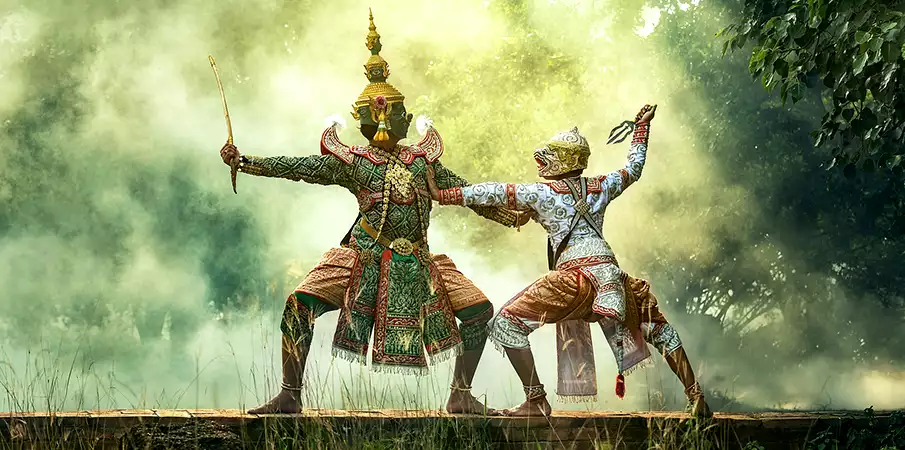
❓ Questions + Tips – Interesting Facts about Thailand:
1. What are the must-visit historical sites in Thailand?
-
- Thailand’s historical tapestry is vivid, and Ayutthaya Historical Park serves as a captivating window into the country’s past. Recognized as a UNESCO World Heritage site, the park encompasses the remnants of Ayutthaya, the former capital. Visitors can explore the grandeur of temples and palaces, including Wat Phra Si Sanphet and Wat Mahathat, providing a glimpse into the glory of the ancient Siamese kingdom.
2. Tell me about the cultural significance of Wat Pho in Bangkok.
-
- Wat Pho, nestled in the heart of Bangkok, is not only one of the city’s oldest and largest temples but also a bastion of cultural significance. Home to the Reclining Buddha, a colossal golden statue representing Buddha’s entry into Nirvana, Wat Pho is also a center for traditional Thai medicine and massage. The temple’s rich history and commitment to cultural practices make it a must-visit.
3. Are there any hidden gems in terms of temples or historical sites?
-
- Wat Rong Khun, or the White Temple, in Chiang Rai is a contemporary masterpiece that stands out amidst Thailand’s historical treasures. The intricate white design symbolizes purity, and the unconventional murals inside, blending traditional Buddhist motifs with modern pop culture references, offer a unique and thought-provoking artistic perspective.
4. What natural wonders does Thailand offer?
-
- Thailand’s natural wonders are diverse and captivating. The Phi Phi Islands, with their crystal-clear waters and limestone cliffs, epitomize tropical paradise. The Similan Islands, a diver’s haven, boast vibrant coral reefs and marine life. Inland, Khao Sok National Park’s emerald lake and lush jungles provide a tranquil escape into nature’s embrace.
5. Tell me about the significance of the Grand Palace in Bangkok.
-
- The Grand Palace, an architectural marvel in the heart of Bangkok, is a testament to Thailand’s monarchy and cultural heritage. Within its sprawling complex, Wat Phra Kaew houses the revered Emerald Buddha, a symbol of Thai Buddhism. The Grand Palace’s intricate design and opulent structures reflect the country’s historical grandeur.
6. Can you recommend any off-the-beaten-path destinations in Thailand?
-
- For a serene mountain retreat, Pai in Northern Thailand offers a laid-back atmosphere, hot springs, and breathtaking landscapes. Koh Lanta, a less crowded island, provides a tranquil beach experience, allowing visitors to immerse themselves in the natural beauty and local culture away from the bustling tourist hubs.
7. What traditional Thai festivals should travelers experience?
-
- Songkran, the Thai New Year, transforms the country into a water-filled playground with vibrant water fights symbolizing cleansing and renewal. Loy Krathong, the Festival of Lights, involves floating decorated baskets on water to pay respects to the goddess of rivers, creating a magical and visually stunning celebration.
8. Tell me about the floating markets in Thailand.
-
- Damnoen Saduak Floating Market near Bangkok is a cultural spectacle. Vendors on traditional longtail boats sell fresh produce, local snacks, and handmade crafts. The market’s vibrant atmosphere and unique shopping experience showcase the essence of Thai river culture.
9. What role does Buddhism play in Thai culture?
-
- Buddhism is deeply ingrained in Thai culture, shaping both spiritual and daily aspects of life. Temples, or wats, are not just places of worship but integral to communities. Respect for monks, engagement in religious ceremonies, and the practice of Buddhist teachings contribute to the cultural fabric of Thailand.
10. How has Thailand preserved its cultural heritage in the face of modernization?
-
- Thailand has embraced a balanced approach to modernization while preserving its cultural heritage. Museums, historical parks, and restoration projects, such as those in Ayutthaya, showcase the country’s commitment to safeguarding its rich past. Traditional arts, dance, and festivals continue to thrive alongside modern influences.
11. Tell me about the diverse cuisine in Thailand.
-
- Thai cuisine is a gastronomic journey, renowned for its vibrant flavors. From the iconic Pad Thai and Tom Yum soup to the aromatic Green Curry, Thai dishes offer a harmonious blend of sweet, sour, salty, and spicy tastes. Exploring street food markets provides an authentic culinary adventure, revealing the depth of Thailand’s culinary artistry.
12. What are some unique Thai cultural practices or customs?
-
- The Wai, a gesture of greeting and respect, involves placing the palms together in a prayer-like position. The Phi Ta Khon festival in Loei, featuring colorful masks and vibrant processions, adds a touch of the mystical to Thai culture, showcasing the country’s rich tradition of folklore and celebrations.
13. Are there any wildlife sanctuaries or conservation efforts in Thailand?
-
- Thailand is committed to wildlife conservation. The Elephant Nature Park in Chiang Mai is a notable sanctuary, providing a humane environment for rescued elephants. Conservation initiatives focus on protecting endangered species like tigers and sea turtles, ensuring the ecological balance of Thailand’s diverse ecosystems.
14. How does traditional Thai architecture differ across regions?
-
- Traditional Thai architecture exhibits regional variations. In the north, intricate wooden temples like Wat Phra Singh showcase unique craftsmanship. In the south, buildings often feature a blend of Thai and Islamic styles, influenced by the region’s historical interactions and cultural diversity. The architectural diversity mirrors the rich tapestry of Thailand’s regional histories.
15. How to explore Thailand – What are the transport options?
-
- In Thailand you can use various options of transport for traveling. The most popular options for tourists are trains (Thailand Railway Map), buses, minivans and boats. But you can also travel by private car/taxi, motorbike / scooter (IDP is necessary) or you can also travel by plane and use domestic flights.
16. What is the weather and climate in Thailand?
-
- Weather in Thailand varies across three main seasons, creating a tropical climate. The hot season typically spans from March to June, with temperatures ranging from 77°F to 95°F (25°C to 35°C). During this period, the weather is characterized by intense heat and occasional brief showers. The rainy season occurs from July to October, bringing heavy monsoon rains and increased humidity. Average temperatures remain high, ranging from 77°F to 88°F (25°C to 31°C). The cool season, from November to February, is marked by milder temperatures and lower humidity. Average temperatures range from 64°F to 86°F (18°C to 30°C), making it a popular time for tourism.
17. What is the official currency of Thailand and how to exchange money?
-
- The official currency of Thailand is the Thai Baht (THB). To exchange money, you can visit banks, currency exchange booths, or use ATMs. Banks typically offer competitive exchange rates, but may charge transaction fees. Currency exchange booths are convenient, often open longer hours, but their rates might be less favorable. Using ATMs connected to banks is a common and convenient option; however, be mindful of potential withdrawal fees from both your home bank and the local Thai bank. Always check rates and fees beforehand to make informed choices.
BOOK a TOUR / ACTIVITY in Thailand ➜
| Interesting Facts about Thailand: | Detailed Descriptions |
|---|---|
| 1. Land of Smiles and Hospitality: |
Thailand, often referred to as the „Land of Smiles,“ is renowned for its warm hospitality and the friendly nature of its locals. The Thai people’s welcoming attitude creates a vibrant and inviting atmosphere, making visitors feel embraced by the country’s unique charm from the moment they arrive. Whether exploring bustling markets or serene temples, the genuine smiles of the Thai people contribute to the overall warmth of the nation. |
| 2. Elephants, National Symbols: |
Elephants hold a special place in Thai culture and are considered national symbols. Revered for their strength, intelligence, and gentle nature, elephants play a significant role in religious ceremonies, festivals, and even royal processions. Visitors to Thailand can witness these majestic creatures in ethical elephant sanctuaries, contributing to the nation’s commitment to wildlife conservation and protection. |
| 3. Songkran Water Festival: |
Songkran, the Thai New Year, is celebrated with the world’s largest water fight. This joyous festival takes place in April, marking the arrival of the rainy season and symbolizing the cleansing of the past year’s misfortunes. Streets across the country transform into water battlefields, with locals and visitors alike joyfully participating in this lively and refreshing tradition. |
| 4. Floating Markets of Damnoen Saduak: |
Damnoen Saduak is home to iconic floating markets where vibrant boats ply the canals selling fresh produce, local crafts, and delectable street food. Navigating these lively markets offers more than a shopping experience; it provides a glimpse into traditional Thai life, highlighting the cultural significance of waterways in the country’s commerce and daily activities. The floating markets are a colorful tapestry of sights, sounds, and flavors. |
| 5. Temples of Ayutthaya: |
The ancient city of Ayutthaya, a UNESCO World Heritage Site, boasts a mesmerizing collection of temples and ruins that reflect the historical grandeur of Thailand. Once the capital of the Kingdom of Siam, Ayutthaya’s temples, including Wat Mahathat and Wat Phra Si Sanphet, stand as testament to the nation’s rich cultural heritage. Exploring this archaeological wonder offers a journey back in time, unraveling the stories engraved in the stone structures. |
| 6. Thai Cuisine’s Culinary Delights: |
Thai cuisine is celebrated globally for its bold flavors, aromatic herbs, and vibrant colors. From the iconic Pad Thai to the spicy Tom Yum soup, each dish tells a tale of Thailand’s diverse culinary heritage. The delicate balance of sweet, savory, spicy, and sour flavors creates a culinary symphony that captivates the taste buds. Exploring the local markets and street food stalls unveils a world of culinary delights, making Thailand a paradise for food enthusiasts. |
| 7. Phi Phi Islands‘ Tropical Paradise: |
The Phi Phi Islands, with their crystal-clear waters, pristine beaches, and towering limestone cliffs, embody Thailand’s tropical paradise. Koh Phi Phi Don and Koh Phi Phi Leh, part of this archipelago, offer stunning landscapes, vibrant coral reefs, and the famous Maya Bay. These islands attract beach lovers, snorkelers, and divers seeking an idyllic escape into nature’s beauty, where turquoise waters meet lush greenery. |
| 8. Loy Krathong Lantern Festival: |
Loy Krathong, the Festival of Lights, is celebrated by floating decorated baskets (krathongs) on water to pay respects to the goddess of water. The release of sky lanterns adds to the enchanting spectacle, creating a magical atmosphere across Thailand’s rivers and lakes. The festival signifies letting go of negativity and embracing positivity, with the twinkling lights reflecting the hopes and dreams of the participants. It is a mesmerizing cultural experience that showcases the spiritual and artistic essence of Thai traditions. |
| 9. Tuk-Tuks, Iconic Transportation: |
Tuk-tuks, three-wheeled motorized rickshaws, are iconic symbols of Thai transportation. Found in bustling cities and serene villages alike, these colorful and nimble vehicles offer a unique and exhilarating way to navigate the lively streets of Thailand. The open-sided design allows passengers to immerse themselves in the sights, sounds, and aromas of their surroundings, creating an adventurous and quintessentially Thai mode of transport. |
| 10. The Grand Palace in Bangkok: |
Bangkok’s Grand Palace is a breathtaking architectural marvel that served as the official residence of the Thai monarch for over 150 years. The complex includes the awe-inspiring Wat Phra Kaew, home to the Emerald Buddha, a sacred and revered symbol for the Thai people. The intricate details of the palace’s design, the dazzling colors, and the historical significance make it a must-visit destination for those seeking a deeper understanding of Thailand’s royal heritage and cultural legacy. |
Interesting Facts in Laos|Solo Travel in Malaysia|Solo Travel in Cambodia|Solo Travel in Vietnam|Vietnamese Culture|Best Islands in Thailand


